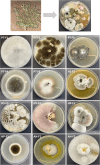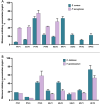Revealing culturable fungal microbiome communities from the Arabian Peninsula desert representing a unique source of biochemicals for drug discovery and biotechnology
- PMID: 40104089
- PMCID: PMC11914873
- DOI: 10.12688/f1000research.158130.1
Revealing culturable fungal microbiome communities from the Arabian Peninsula desert representing a unique source of biochemicals for drug discovery and biotechnology
Abstract
Background: Microbes living at extremes evolve unique survival strategies to adapt to challenging environmental conditions. Among these strategies is their distinctive metabolic potential and ability to produce specialized metabolites enabling them to compete for limited resources and defend against predators. These metabolites have significant potential in pharmaceutical and industrial applications, particularly in the development of drugs and biochemicals.
Objectives: This study aimed to investigate the culturable fungal communities associated with four desert plants and their surrounding soils in the Arabian Peninsula desert to identify their bioactive properties.
Methods: A total of 12 distinct fungal species were isolated from the plants and soils. Each plant hosted a unique set of fungi, demonstrating the diversity of desert-adapted fungal communities. Biological activities of the fungal extracts were evaluated through various assays, including antimicrobial, antifungal, anticancer, and antioxidant properties.
Results: Panicum turgidum harbors the most diverse fungal community, dominated by genera such as Mucor, Aspergillus, Colletotrichum, Alternaria, and Chaetomium. Aspergillus species comprise 33% of the total isolates, followed by Fusarium at 16%. All extracts exhibit diverse activities, with Aspergillus species demonstrating the highest antioxidant activities and total phenolic and flavonoid content. Fungi from P. turgidum, particularly Mucor sp., Aspergillus sp., and Curvularia sp., display potent activity against Staphylococcus aureus, while Mucor sp., Chaetomium sp., and Curvularia sp. exhibit moderate inhibition against Pseudomonas aeruginosa.
Conclusion: This study highlights the importance of exploring extremophilic microorganisms, such as those found in desert ecosystems, as they offer a wealth of compounds that could address current challenges in drug discovery and biotechnology.
Keywords: Desert microbiome; and cytotoxic.; antimicrobial; antioxidant; bioactive molecules; culturable fungi.
Copyright: © 2024 Mousa W et al.
Conflict of interest statement
No competing interests were disclosed.
Figures




References
-
- Rita RS, Sy E: Syzygium Cumini Leaves Extract from West Sumatra Indonesia Alleviate Oxidative Stress by Decreasing Malondialdehyde Level and Enhancing Catalase Activity in Rat Induced by Lead Acetate. Pharmacogn. J. 2021 Nov 13;13(6):1408–1412. 10.5530/pj.2021.13.178 - DOI
MeSH terms
Substances
LinkOut - more resources
Full Text Sources
Medical
Molecular Biology Databases

